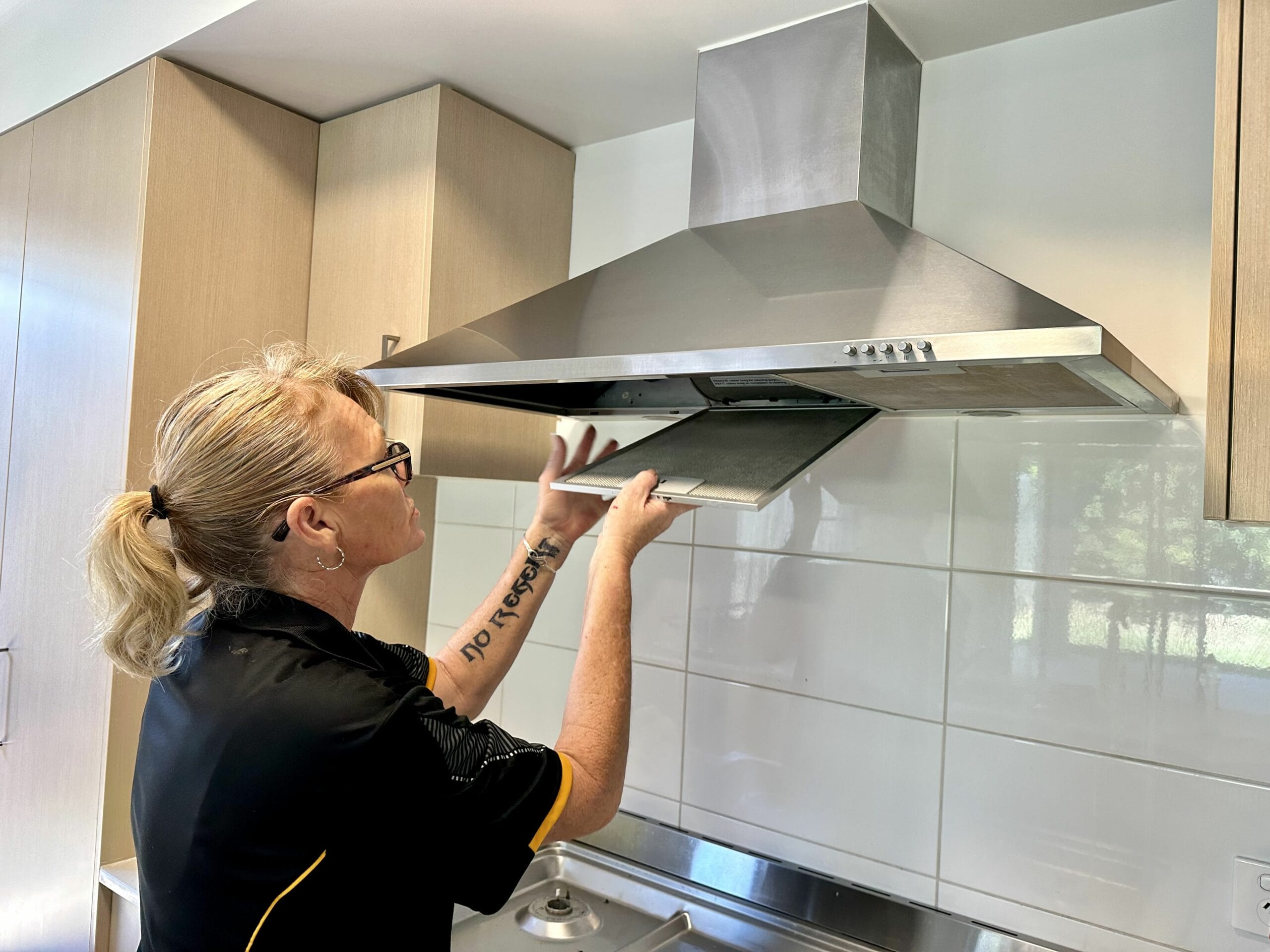A rangehood is the super sidekick to your hard working stove in the kitchen. It’s the unsung hero when you’re cooking up some chicken wings or making a good stir-fry.
While your prawns are sizzling on the cooktop, the rangehood is not-so-quietly hoovering up the oil, smoke, fumes, and other airborne particles. It then filters out all that dirt, keeping your kitchen’s air clean.
Given all that grease and gunk build-up, you’ll need to wash that filter regularly!
How to clean rangehood filters? The best way is to soak the filters in hot water and dish soap, then give them a good scrub. Stainless steel filters can be cleaned with baking soda paste.
The rangehood and filters can be one of the most neglected appliances in your kitchen – so make sure you cook in comfort and breathe easy!
Why Clean Filters? | How Often to Clean | How to Remove | How to Clean | How Often to Replace | Exhaust Fan vs Rangehood
Types of Rangehood Filters
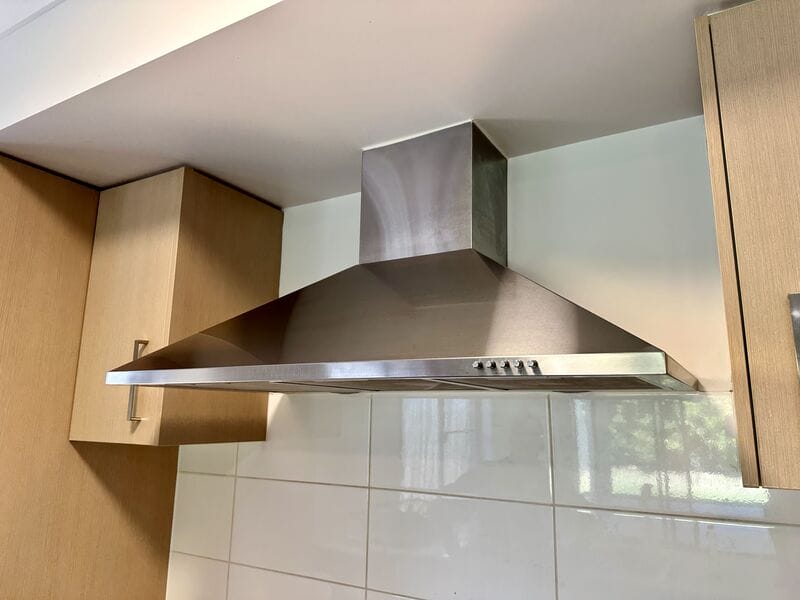
For home kitchens, there are three common types of rangehood filters.
Each has its own pros and cons, but they all function to keep your kitchen’s air clean.
Baffle filters
These are typically made of stainless steel and have vents on multiple sides to increase dirty air intake. A stainless steel baffle filter typically comes with a duct that leads outside.
The filters have grooves or grates that trap grease, vapours, and other particles as the air moves through, preventing them from blowing back into the room.
Any unfiltered particles are then vented out through the duct.
Mesh filters
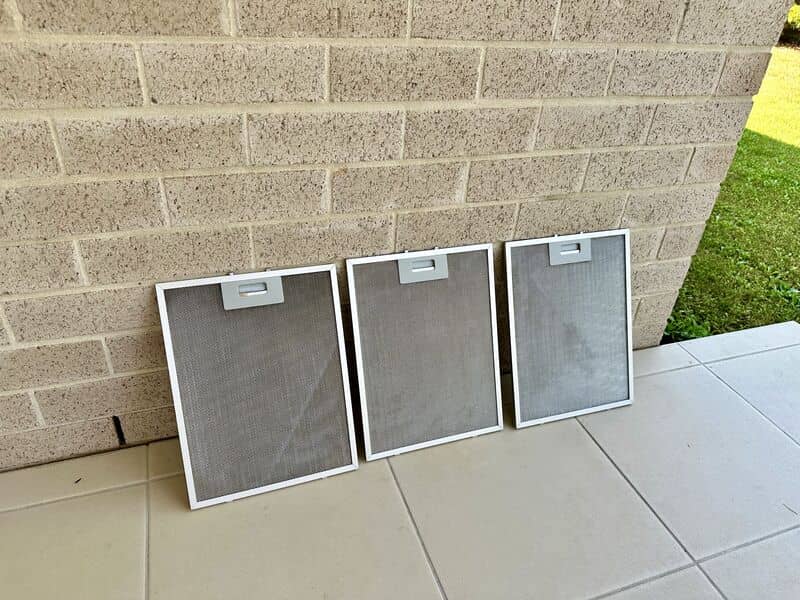
A mesh filter is made from either aluminium or stainless steel. Aluminium is more affordable, but less durable and efficient.
Stainless steel mesh filters are sturdier, last longer, and filter air more efficiently. However, they cost more and are less common.
Aluminium mesh filters sometimes come with a second layer of activated charcoal. The mesh will trap larger particles like grease, while the charcoal or carbon absorbs odours and contaminants.
Hybrid filters
These are a combination of mesh and baffle range hood filters!
The filter has metal baffles or grates attached to an aluminium mesh, which work together to collect airborne grease and dirt.
Charcoal filters
These are most common in ductless rangehoods, since the carbon-based filtration system inside absorbs the odours and particles. The rangehood can then recycle the air without needing to vent anything outside.
However, charcoal filters (or carbon filters) must be replaced regularly since they cannot be cleaned. As grease and grime build up, the filter slowly becomes less efficient – so you’ll need to keep an eye on it.
Charcoal rangehood filters are best for apartments and other residences where ductwork isn’t possible.
Why Clean a Rangehood Filter?
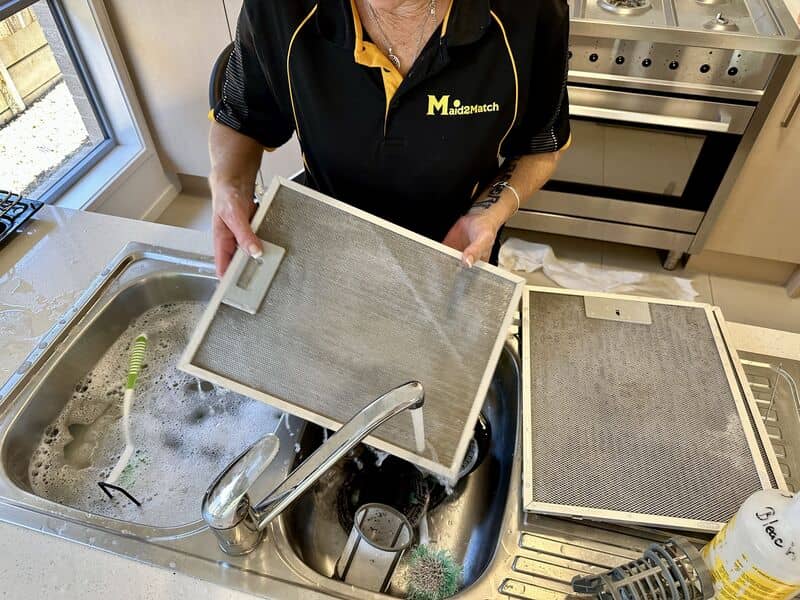
As grease, condensation, and other particles build up in the filter, it gets less and less efficient at… well, filtering!
That build-up can also lead to mould or bacteria growth over time, turning the rangehood into a health hazard.
A dirty filter can also contaminate your HVAC system (if you have a ducted rangehood), creating a fire risk.
How Often to Clean Rangehood Filters
This will depend on how often and how much you cook, and also what you cook! If you’re at the stove daily – or you like stir fries and crispy chicken – then you’ll need to clean more often.
Generally, it’s best to clean rangehood filters every month.
If you don’t cook so much, you can clean the rangehood filter once every 3 months.
Some signs your filter needs cleaning include lingering smoke or strong odours even on higher settings, and loud humming or rattling from the motor.
You should also wash a rangehood filter after any major cooking event! Or give yourself a break after cooking up a storm and book a deep clean with a house cleaning service – rangehood included.
How to Remove Rangehood Filters
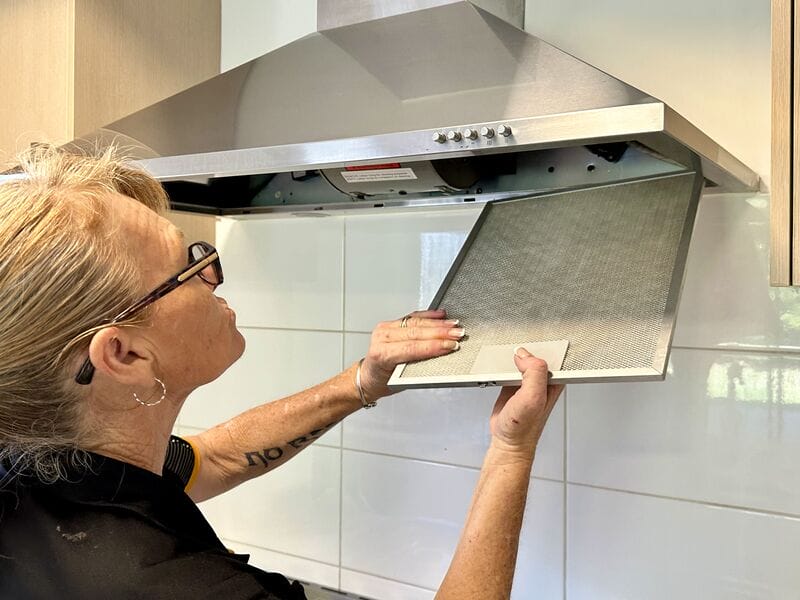
Most filters will either slide or pop out from underneath the hood. Look for a metal loop, knob, or latch that will release the filters.
In some models, you’ll need to unscrew the sides to take the filter down.
Some range hoods with baffle filters need a removal tool to safely lift the baffles out of the appliance. However, these are usually found in professional kitchens, not residential ones.
Always consult your rangehood manual for instructions on how to remove the filter! This ensures you don’t damage the rangehood and void the warranty (or worse, lose your bond if you’re renting).
Follow the manual’s instructions and be careful! If there are screws, place them in a small container or on a small towel so they’re safe and accessible.
How to Clean a Rangehood Filter
When cleaning rangehood filters, you’ll need:
- Hot water
- Anti-grease dish soap
- A non-abrasive scrub brush (like a bottle brush or dish scrubber)
- Baking soda
- Clean cloths (for drying)
For stainless steel filters, you can also use a vinegar cleaning solution for added cleaning power. Do not use vinegar on aluminium as it can corrode the material.
Always make sure the filter is completely dry before putting it back in place.
And of course, don’t forget to clean the rangehood itself! You can time it so you’re also cleaning your stovetop or oven – we love efficiency in the kitchen.
Cleaning a baffle filter
You can clean rangehood filters with baking soda! This is most effective for baffle filters.
To start, loosen any residue by soaking the baffle filter! Fill the sink or bathtub with hot water and a good squirt of anti-grease dish soap, then let the filter soak for about 10 minutes.
Make a paste from warm water, baking soda, and dish soap. Use a soft sponge or soft brush to apply the paste onto the grooves and other surfaces.
Let it sit for a few minutes, then scrub the filter with the sponge or brush. Rinse thoroughly and dry.
You can also spray the filter with equal parts white vinegar and water as a natural degreaser. Wipe it dry with a microfibre cloth.
Some baffle filters are dishwasher-safe, although wipe or wash the filter first – especially if you haven’t cleaned it in a while. Otherwise, you could clog your dishwasher with all the grease.
NOTE: For a more thorough cleaning, spray the filter with Dawn Powerwash! It works on stainless steel and cuts through grease quite well.
Do not use it for hybrid or mesh filters as Powerwash can react with aluminium and cause discolouration or damage.
Cleaning a mesh filter
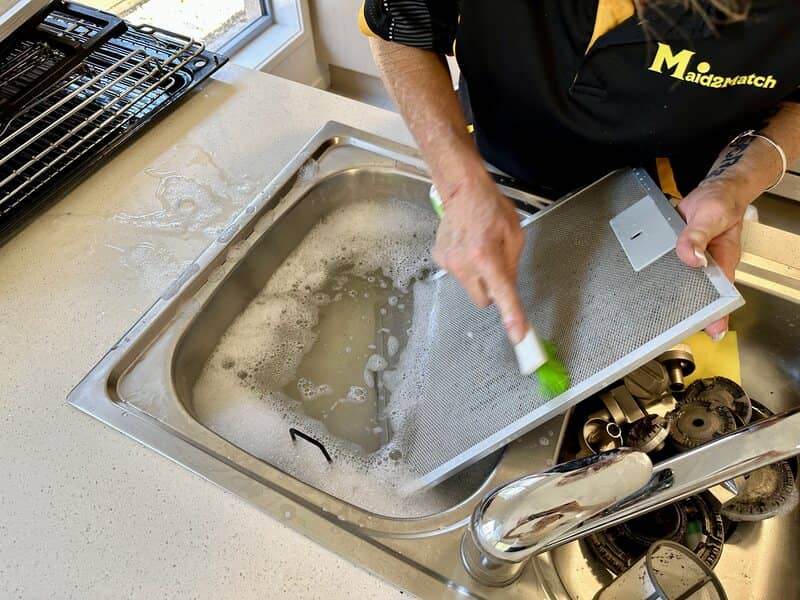
These are a bit trickier to clean since grease and other dirt clings to the fine mesh. It’s best to hand wash mesh and hybrid filters.
To wash mesh rangehood filters, fill up your sink or bathtub with hot water plus a few tablespoons of anti-grease dish soap. Make it as hot as possible – boiling water from a kettle works great.
Add half a cup of baking soda, then give it a good mix with a non-abrasive scrub brush (don’t touch the water or you’ll scald yourself!).
Dunk the filters into the hot, soapy water and let them soak for 10-15 minutes. Afterwards, use the scrub brush to scrub off any grease and grime.
Rinse with more hot water, then dry them thoroughly.
How Often to Replace Rangehood Filters
Cleaning rangehood filters ensures they function properly and extends their lifespan, but they won’t last forever! Replacing rangehood filters is also part of proper maintenance.
MESH FILTERS: It’s best to replace mesh filters once a year (or every 2 years if you don’t cook as often). This applies to hybrid filters as well.
CHARCOAL FILTERS: It’s best to change a charcoal filter every 120 hours of cooking or every 3 months, whichever is sooner.
Baffle filters typically don’t need replacing unless they show signs of damage such as rust, corrosion, or warping.
Make sure you get the right rangehood filter replacements – check the manual or look up the model online to find a compatible replacement.
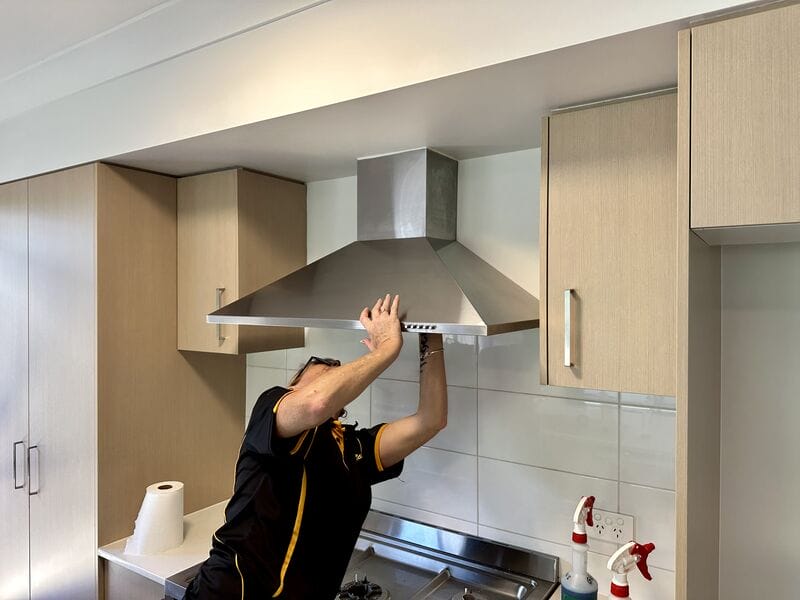
Exhaust Fan vs Rangehood
While people use “rangehood,” “kitchen exhaust,” and “exhaust hood” interchangeably, a rangehood is different from an exhaust fan.
A rangehood (or range hood) is an appliance mounted over your stovetop, which captures and filters out airborne grease, smoke, fumes, steam, and other combustion products.
It can either vent the particles outdoors through a duct or circulate the air through carbon filters to clean and deodorise it.
Rangehoods can extract large amounts of air and can tolerate high temperatures from stoves. However, they have a high upfront cost – especially if you get a ducted version.
Moreover, kitchen exhaust filter cleaning is essential to keep your rangehood functioning correctly.
On the other hand, an exhaust fan (or vent) is a small fan mounted on either the ceiling or the wall. It helps remove excess heat and push air out of the kitchen.
Exhaust fans are typically more affordable and easier to install, although they can be noisy. They’re less effective in large kitchens since they move less air, and don’t filter out grease.
Some exhaust fans have a dust filter. You can clean exhaust fan filters with the same method as mesh filters – give them a soak in some hot, soapy water, then scrub and dry.
FAQs about Maintaining Rangehood Filters
Here are some key tips for maintaining a rangehood filter, and some answers to common cleaning questions!
How to minimise grease on a rangehood filter?
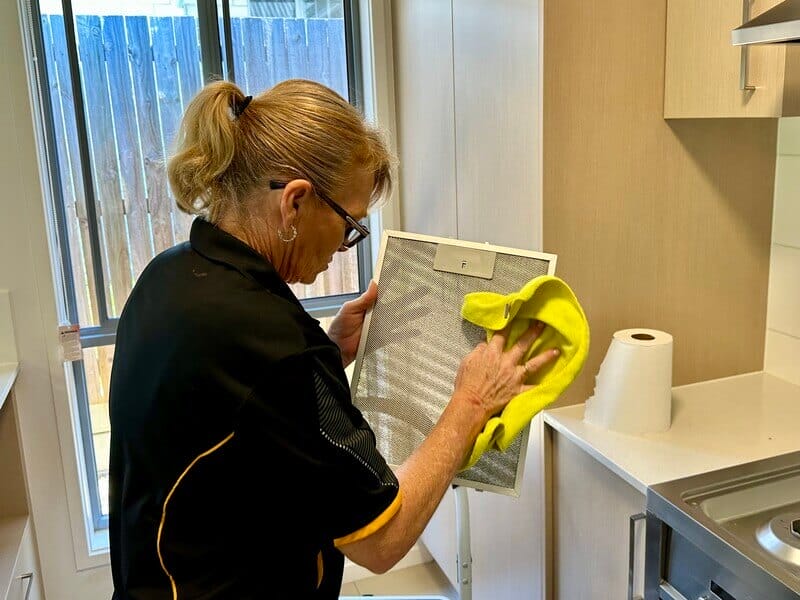
Rangehood filters are supposed to collect grease and other airborne particles, so it’s difficult to minimise the amount of dirt they get.
Still, you can lessen the build-up of oils and dirt on your rangehood by wiping it down with a degreaser or a vinegar solution once a week.
You can also quickly wipe underneath the rangehood with a paper towel after cooking.
Can you put rangehood filters in the dishwasher?
Some models have rangehood filters that are dishwasher-safe! Check the manual beforehand to make sure.
Use the pots and pans setting, or whichever is hottest.
If you don’t have the manual or you’re just not sure, hand washing is always a safe method.
Can you clean rangehood filters with Napisan?
You can use bleach-free Napisan to clean a stainless steel rangehood filter, but not an aluminium one!
Napisan contains sodium percarbonate, which reacts with aluminium to cause pitting and discolouration.
Do not use Napisan on aluminium hybrid or mesh filters.
What is the best way to clean a range hood filter?
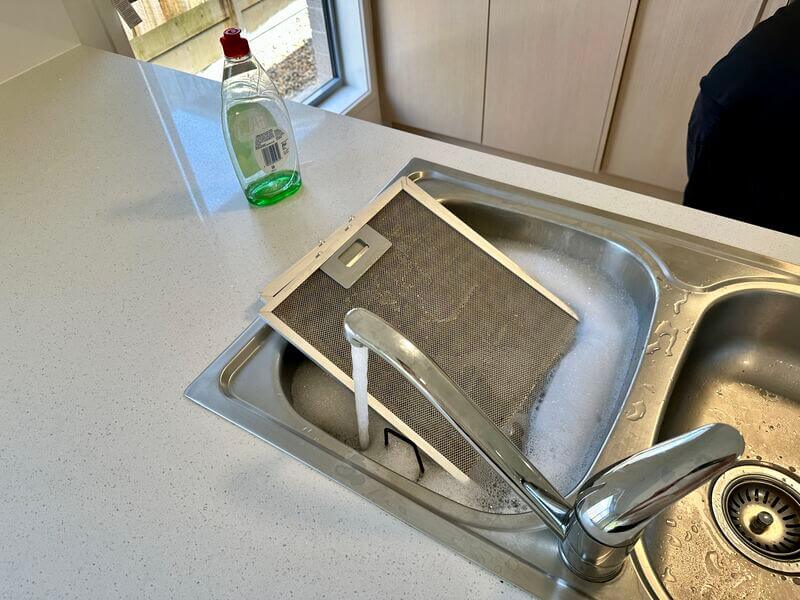
The best way to clean grease from range hood filters is a good soak in hot water and anti-grease dish soap!
You can also add baking soda as it can absorb odours and grease.
Do I need to clean a rangehood filter duct?
So long as you properly maintain your rangehood and filter, there should be little reason to clean the duct.
The filter is responsible for collecting airborne grease, dirt, and other particles so the duct is only venting out air.
However, if the rangehood malfunctions or a mess happens, it’s best to find a professional! Duct cleaning is a specialised service, and it’ll be difficult for you to access the ductwork by yourself.

